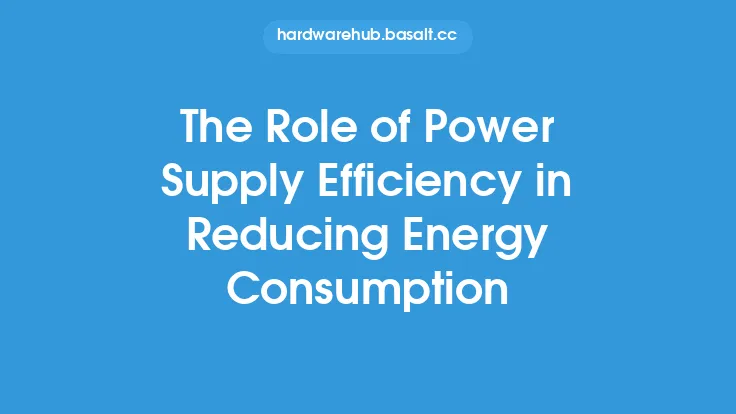High efficiency in power supplies is crucial for ensuring reliable operation, reducing energy consumption, and minimizing the environmental impact of electronic devices. A power supply's efficiency is determined by its ability to convert input power from the mains to output power for the device, with minimal energy loss as heat. In this article, we will delve into the importance of high efficiency in power supplies, exploring the technical aspects, benefits, and considerations for achieving optimal efficiency.
Introduction to Power Supply Efficiency
Power supply efficiency is typically measured by the ratio of output power to input power, expressed as a percentage. For example, an 80% efficient power supply will output 80 watts of power for every 100 watts of input power, with the remaining 20 watts lost as heat. The most common measure of power supply efficiency is the 80 PLUS certification, which sets standards for efficiency at various load levels. High efficiency power supplies typically have an 80 PLUS rating of Gold, Platinum, or Titanium, indicating efficiency levels of 90%, 92%, and 94%, respectively.
Technical Aspects of High Efficiency Power Supplies
High efficiency power supplies employ various technologies to minimize energy loss and maximize output power. One key technique is the use of switching regulators, which rapidly switch the output voltage on and off to reduce energy loss. Additionally, high efficiency power supplies often utilize synchronous rectification, which replaces traditional diode rectifiers with power MOSFETs to reduce voltage drop and increase efficiency. Other technologies, such as active power factor correction (PFC) and resonant converters, can also contribute to high efficiency. Furthermore, the design and selection of components, such as capacitors, inductors, and transformers, play a critical role in determining the overall efficiency of the power supply.
Benefits of High Efficiency Power Supplies
The benefits of high efficiency power supplies are numerous and significant. Firstly, they reduce energy consumption, which not only saves money on electricity bills but also decreases the environmental impact of electronic devices. High efficiency power supplies also produce less heat, which can improve reliability and reduce the risk of overheating. Moreover, high efficiency power supplies often have a longer lifespan, as they are designed to operate at lower temperatures and with reduced stress on components. Additionally, high efficiency power supplies can help to reduce electromagnetic interference (EMI) and radio-frequency interference (RFI), which can improve overall system performance and reliability.
Considerations for Achieving High Efficiency
Achieving high efficiency in power supplies requires careful consideration of several factors, including the design and selection of components, the choice of topology, and the implementation of control strategies. The design of the power supply's printed circuit board (PCB) is also critical, as it can affect the thermal performance and electromagnetic compatibility (EMC) of the power supply. Furthermore, the selection of the power supply's input and output connectors, as well as the cabling and wiring, can impact efficiency and reliability. Additionally, the power supply's control strategy, including the use of pulse-width modulation (PWM) and feedback control, can significantly affect efficiency and performance.
Applications of High Efficiency Power Supplies
High efficiency power supplies are used in a wide range of applications, from consumer electronics and computers to industrial and medical devices. In the consumer electronics sector, high efficiency power supplies are used in devices such as smartphones, laptops, and televisions. In the computer sector, high efficiency power supplies are used in desktops, servers, and data centers. In industrial and medical applications, high efficiency power supplies are used in devices such as motor drives, medical imaging equipment, and laboratory instruments. The use of high efficiency power supplies in these applications can help to reduce energy consumption, improve reliability, and minimize the environmental impact of electronic devices.
Conclusion
In conclusion, high efficiency in power supplies is essential for ensuring reliable operation, reducing energy consumption, and minimizing the environmental impact of electronic devices. By understanding the technical aspects, benefits, and considerations for achieving high efficiency, designers and manufacturers can create power supplies that meet the demands of modern electronic devices. As the demand for energy-efficient and environmentally friendly devices continues to grow, the importance of high efficiency power supplies will only continue to increase. By prioritizing high efficiency in power supplies, we can help to reduce our carbon footprint, improve system reliability, and create a more sustainable future for electronic devices.





